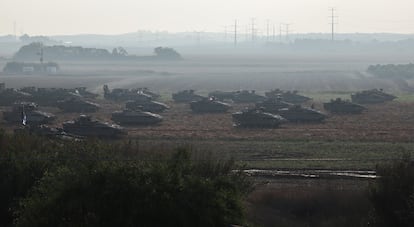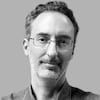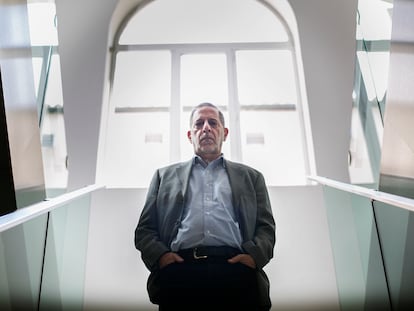How can the conflict between Hamas and Israel worsen? Six scenarios for an escalation that is keeping the world on edge
Warning signs abound on several fronts: an invasion of Gaza, violence in the West Bank, a Hezbollah attack, U.S. regional involvement, Islamic terrorism and Islamophobia

The conflagration unleashed by Hamas’ attack on Israel is already causing immense suffering. Multiple elements point to the fact that it is only the beginning of a conflict that will produce much more violence. It is likely to develop on several fronts.
The invasion of Gaza seems imminent, and the West Bank is a hotbed of protests and lethal repression. There are already low-intensity exchanges of fire between Hezbollah and Israel, and U.S. forces are under attack in Syria and Iraq, while American aircraft carriers deployed in the Mediterranean are intercepting rockets from Yemen. The specters of Islamic terrorism, anti-Semitism and Islamophobia snake through many societies.
Here is a look at six possible scenarios for the development of the conflict.
The invasion of Gaza
The first step in the dreaded escalation. Israel has declared its intention to destroy Hamas in response to the October 7 attack. The readiness of its armed forces and the messages of its politicians clearly point to a willingness to enter the Gaza Strip.
This is a highly complex military operation, due to the urban characteristics of Gaza and Hamas’ preparedness and lack of scruples in such a scenario. It is rational to fear enormous human suffering. These circumstances would undoubtedly provoke a new wave of global outrage — especially in the Arab world, where the streets are already filled with protests — and increasing pressure on other actors to intervene in the conflict.
The second front: Hezbollah
This is the main risk of war escalation. The Iranian-backed Lebanese Shiite militia party has a large arsenal of missiles. Experts consider the possibility of an all-out front in this sector to be high, and there is already an exchange of fire, although not of high intensity.
The United States and other Western countries have asked their citizens to leave Lebanon. Israel is evacuating villages in the northern part of the country. The presence of Hezbollah units and pro-Iran militias in Syria also raises fears that if this front breaks out, Israel could also come under attack from Syrian territory.
Lebanon has been in the throes of a dreadful economic and social crisis for years, and it is probable that a large part of Lebanese society hopes that a war will not be added to its tribulations. But Hezbollah responds to a logic alien to the national interest, and the country’s government and armed forces are not in a position to control it.
U.S. involvement
Since the Hamas attack on Oct. 7, U.S. forces deployed in the region have suffered several attacks. A drone attacked U.S. troops in Syria on Wednesday. On Thursday, in Iraq, two bases hosting U.S. forces were attacked. Also on Thursday, a Washington ship in the Red Sea intercepted 19 missiles fired from Yemen to the north.
The episodes are proof of the risk of regional escalation in areas where Iranian-backed militias are present. Not only Hezbollah in Lebanon, but also other groups in Syria, Iraq, and Yemen.
Despite the total withdrawal from Afghanistan and almost total withdrawal from Iraq, the United States still had some 30,000 military personnel and huge resources in the region. Following the attack on Israel, it has increased its deployment. The aircraft carrier Gerald Ford is already in the eastern Mediterranean, and the Dwight Eisenhower is due to arrive there soon. It has also increased its air force at land bases, moved a unit of 2,200 Marines to the region and has others on standby for rapid deployment.
The maneuvers are clearly intended as a military deterrent. It remains to be seen how the U.S. would react in the event of escalation. Meanwhile, the State Department has issued an extraordinary global alert for its citizens worldwide.

Violence in the West Bank
Israel’s response to the Hamas attack has already triggered large protests and outbreaks of violence. On Thursday alone, at least eight Palestinians were killed in clashes with Israeli forces.
Some define this as the potential third front (in addition to Gaza and Hezbollah). Naturally, it has different characteristics; it’s not conventional warfare. The Palestinian Authority has renounced violence as a means to achieve its political ends.
But the West Bank society is seething with indignation at the endless subjugation of occupation and colonization, and at the scenes of suffering caused by the Israeli response in Gaza. The Palestinian political power is discredited and marked by very serious limits. An intifada-style insurrection may break out and extremist cells could take advantage of the situation. Polls point to growing social support for the idea of armed struggle.
The situation was extremely tense even before the current crisis. So far this year, up to October 7, some 220 Palestinians had been killed in violent episodes largely related to the presence of Israeli settlers. Some 29 Israelis were killed in the same period, according to UN data.
Islamic terrorism and anti-Semitism
Another potential risk linked to the crisis is the resurgence of Islamic terrorism. They could begin to target Western countries that are backing Israel.
In recent days, France has been in a state of heightened alert, especially after the murder of high school teacher Dominique Bernard, a victim of a stabbing by the Russian-Chechen Islamist Mohamed Mogouchkov. The country has also suffered numerous false terrorist threats, which for example led to the Louvre Museum and the Palace of Versailles being evacuated and temporarily closed. In Belgium, a terrorist murdered two Swedish citizens. Many Western countries have raised their state of alert and police operations are underway.
In parallel, Israel’s military actions in response to the Hamas attack, considered by many as disproportionate and causing intolerable suffering to civilians, threaten to fuel anti-Semitism. London police reported Friday that so far this month 218 episodes of anti-Semitism were recorded in the British capital, compared with 15 in the same period last year. Two Molotov cocktails were thrown this week at a synagogue in Berlin. The Prime Minister of Canada, Justin Trudeau, denounced a sharp increase in anti-Semitic acts in his country in recent days.
Islamophobia
At the same time, the spiral of tension can also fuel Islamophobia, a sentiment well present in Western societies and at the edge of which rising far-right formations move. The same London police report mentioned above on anti-Semitism also detected an increase in Islamophobia, with 101 cases compared to 42 in the same period last year. An American Muslim civil society organization moved its annual conference to an undisclosed location this week due to threats. And a 6-year-old Palestinian-American child was killed last week in an anti-Muslim attack in Illinois, U.S.
Sign up for our weekly newsletter to get more English-language news coverage from EL PAÍS USA Edition
Tu suscripción se está usando en otro dispositivo
¿Quieres añadir otro usuario a tu suscripción?
Si continúas leyendo en este dispositivo, no se podrá leer en el otro.
FlechaTu suscripción se está usando en otro dispositivo y solo puedes acceder a EL PAÍS desde un dispositivo a la vez.
Si quieres compartir tu cuenta, cambia tu suscripción a la modalidad Premium, así podrás añadir otro usuario. Cada uno accederá con su propia cuenta de email, lo que os permitirá personalizar vuestra experiencia en EL PAÍS.
¿Tienes una suscripción de empresa? Accede aquí para contratar más cuentas.
En el caso de no saber quién está usando tu cuenta, te recomendamos cambiar tu contraseña aquí.
Si decides continuar compartiendo tu cuenta, este mensaje se mostrará en tu dispositivo y en el de la otra persona que está usando tu cuenta de forma indefinida, afectando a tu experiencia de lectura. Puedes consultar aquí los términos y condiciones de la suscripción digital.
More information
Archived In
Últimas noticias
Russell Tovey: ‘I was advised many times not to come out, I don’t think there was many people who’d done that — and I feel really proud that I’m one of those that did’
Patagonia’s puma population soars thanks to unexpected prey: penguins
Merz tries to replace Macron at the helm of Europe
Indulgence, punishment and family dynamics: Maintaining a healthy relationship with food during the holiday season
Most viewed
- Christian Louboutin: ‘Young people don’t want to be like their parents. And if their parents wear sneakers, they’re going to look for something else’
- The low-cost creative revolution: How technology is making art accessible to everyone
- US sanctions against jailed cartel leader ‘El Marro’ highlight Mexico’s lack of control over its prisons
- Liset Menéndez de la Prida, neuroscientist: ‘It’s not normal to constantly seek pleasure; it’s important to be bored, to be calm’
- Cartels in Mexico take a leap forward with narco-drones: ‘It is criminal groups that are leading the innovation race’











































